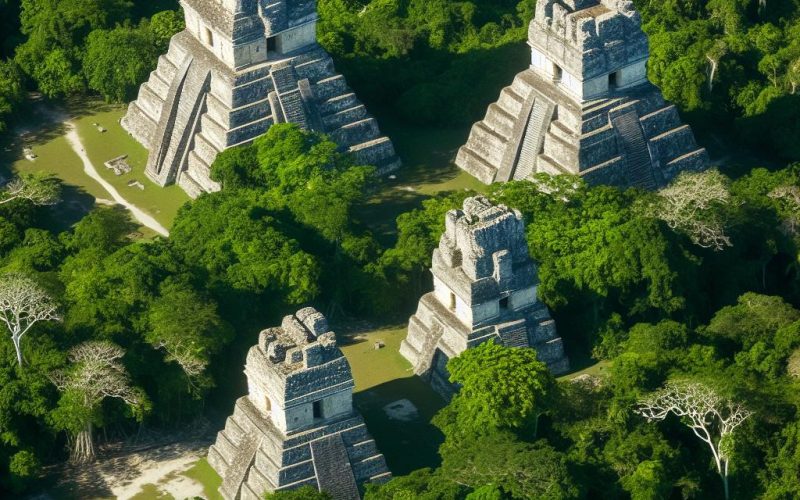Historical Overview of Tikal
Tikal, a monumental city located in present-day Guatemala, stands as a testament to the sophistication and power of the ancient Maya civilization. It flourished during the Classic Period, roughly from 200 to 900 AD. This time was marked by significant developments in art, architecture, and political structure within the Maya world. Tikal’s vast influence reached beyond its immediate surroundings, situating it as a pivotal force in the political, economic, and military arenas of the ancient Maya.
Geographical and Environmental Context
Nestled in the dense rainforests of northern Guatemala, Tikal forms a part of the Maya Biosphere Reserve. This location was strategic, enabling the city to access essential resources that were critical to its development and sustainability. Fertile lands facilitated agricultural activities, while the surrounding forests provided a bounty of resources. The area’s seasonal climate profoundly affected Tikal’s agricultural techniques, such as the cultivation of maize and other staple crops, influencing how the city was planned and how it thrived. These environmental factors contributed significantly to Tikal’s expansion and the sustenance of its large population.
Architecture and Urban Layout
Tikal is celebrated for its architectural ingenuity and urban planning, which reveal the Maya’s advanced knowledge and skills. The city is renowned for towering pyramids, expansive palaces, and intricate plazas. Among its famous structures are Temple I, also known as the Temple of the Great Jaguar, and Temple II, the Temple of the Masks. These magnificent edifices exemplify the Maya’s sophistication in construction, displaying their artistic flair and engineering prowess.
The city’s urban layout was meticulously planned, a network of causeways connecting the various sectors of the city. These pathways facilitated trade, communication, and movement within Tikal. The many stelae and altars scattered throughout the city offer glimpses into its history, picturing the rulers and political narratives of Tikal. Each monument tells a story, contributing to our understanding of Maya society and its evolution over centuries.
The Role of Religion and Ceremonial Centers
Religion was integral to Tikal’s societal structure, deeply influencing its governance and social hierarchies. The city was a ceremonial nucleus, where numerous rituals and offerings to the deities were performed. These religious activities were intertwined with the administrative functions of the city, reflecting the theocratic nature of Maya society. The central acropolis served as a key ceremonial center, providing a venue for religious observances and reinforcing the socio-religious order of the time. The grandeur of these locations highlighted the significance of religion and its impact on Tikal’s daily functioning and political decisions.
Interactions with Neighboring City-States
Tikal was not a solitary city-state; it actively interacted with other prominent cities within the Maya world. Among these interactions, its relationships with cities such as Calakmul and Caracol were particularly noteworthy. These relationships were characterized by intricate patterns of alliances and rivalries, which played a crucial role in shaping Tikal’s political landscape. Diplomatic ties and conflicts with neighboring states led to periods of territorial expansion and sometimes warfare, making Tikal a strategic center of power in the region. Understanding these interactions provides deeper insight into the complex political dynamics that characterized the Maya civilization during this era.
Archaeological Discoveries and Research
Extensive archaeological research has continued to unravel the mysteries of Tikal, offering invaluable insights into the lives and achievements of the ancient Maya. Excavations and studies have uncovered evidence of their advanced knowledge across numerous fields, including astronomy, mathematics, and a unique system of writing. This research has been pivotal in reconstructing the history and culture of Tikal, showcasing the intricacy and achievements of its civilization. Various organizations and independent researchers remain active in their exploration efforts, continually adding to the world’s understanding of Tikal’s storied past.
Preservation and Challenges
Recognized as a UNESCO World Heritage Site, Tikal represents a vital cultural and historical treasure of significant global importance. Both governmental and non-governmental entities are committed to preserving and protecting Tikal for future generations, addressing challenges such as environmental degradation and the pressure exerted by tourism. Sustainable tourism practices and conservation efforts are vital, ensuring that Tikal remains an accessible and enlightening destination for those seeking to immerse themselves in the grandeur of the ancient Maya civilization. By safeguarding Tikal, we enable future generations to study and appreciate one of humanity’s profound historical legacies.
For those interested in further exploring Tikal’s history or planning a visit, there are numerous reputable travel and historical websites that offer in-depth resources on Maya archaeology and the rich history of this remarkable ancient city.
